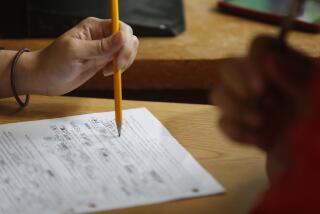Scientists test ability to strengthen, suppress memories
- Share via
Do you wish you could forget that time singing karaoke with your boss or recall the location of that great restaurant you visited last year? Take heart: Scientists are coming closer to being able to turn memories on and off with the flip of a switch.
A team led by Theodore Berger, a professor of biomedical engineering at USC, has figured out how to manipulate brain cells in rats so that memories stored in the hippocampus, a region crucial for memory formation, were activated or suppressed. The technology, scientists said, could one day have medical applications.
In the study, published in the Journal of Neural Engineering, researchers first trained rats on a simple task: remembering which of two levers they pressed first, then learning to press the other lever.
As the rats performed the task, the scientists carefully monitored the electrical activity in each creature’s hippocampus to pinpoint the pattern of nerve-cell activity involved in forging a solid memory.
Then, using the same glass needles they used to record the nerve activity, they stimulated nerves in the same pattern — and found that the animals’ performance on the task got even better. The rats made fewer errors and were able to remember which lever was the “correct” one for a longer period of time.
The scientists went a step further and suppressed the rats’ memory with a drug called MK801, causing them to forget their task. When the animals’ brain cells were later stimulated with the “correct” pattern, they remembered again which lever to press.
“What’s really exciting about this study is that when they played back the ‘good’ patterns — the patterns when the animal got the task right — it did appear to improve memory,” said Dean Buonomano, an associate professor of neurobiology and psychology at UCLA’s Brain Research Institute who was not involved in the research.
“That they were able to achieve what they did is remarkable,” added Dr. Robert Malenka, co-director of the Stanford Institute for Neuro-Innovation and Translational Neuroscience. “They could improve the animal’s performance dramatically — suggesting that in the very distant future, this kind of approach could have clinical applications.”
In collaboration with researchers at Wake Forest University in Winston-Salem, N.C., Berger said he was now preparing to conduct similar studies with primates.
The ultimate goal, he added, is to help people with conditions such as stroke, epilepsy and dementia strengthen memories and to help doctors diagnose memory problems before they worsen.
The technology might even help suppress distressing memories in patients with post-traumatic stress disorder, Malenka said.
But first, researchers would have to show that they can stimulate or repress far more complex memories than the ones in the rat experiment, scientists said.
“Here, it’s a simple task,” Buonomano said. In contrast, humans’ “memories are very rich and specific. We remember different faces, movies, events in our lives.... We have very many steps to go before this can be implemented.”






